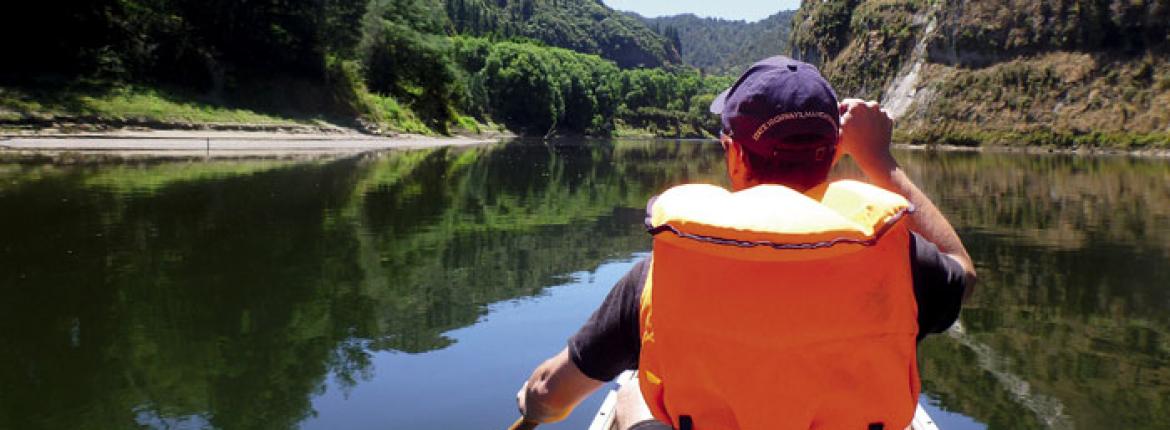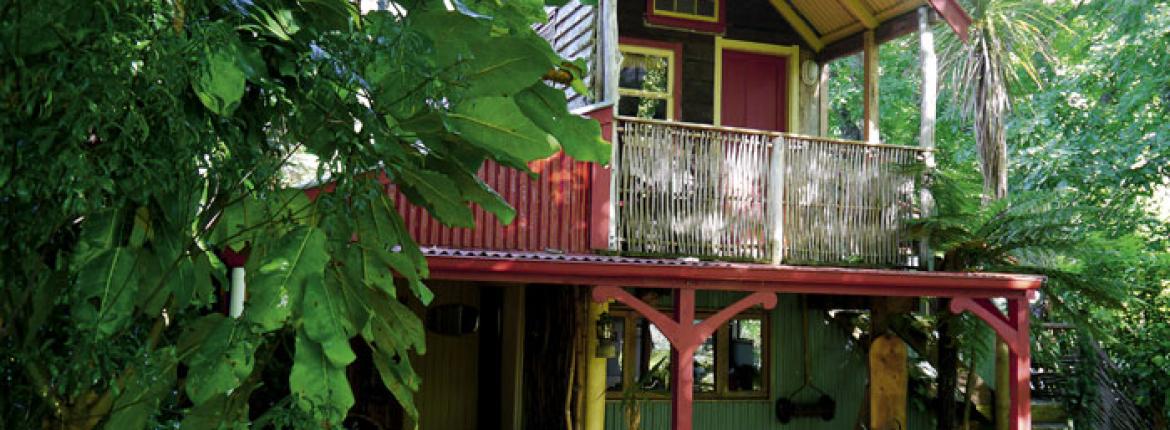As the jet boat bounces its way up the Whanganui River, operator Mark Wickham turns, grins and says; "Ya wanna try a whirly thing?" Not being an intrepid adventurer, I don’t actually know what a ‘whirly thing’ is. But I do know what the correct answer is. I give the thumbs up.
The jet boat lurches swiftly forward accompanied by the racket of its suddenly roaring engine. The vessel’s nose rises sharply out of the water, completely obscuring the landscape and then, almost immediately, everything is not where it should be. As we spin, I realize I’m laughing, but also white-knuckling the side rail.
It’s a stunner of a day on the river, the sky full of blue and plenty of sizzle in the sun. For the past 45 minutes we’ve been relaxing our way upstream partaking in what Mark calls a “dry tour”. Translated, this means we won’t be getting soaked, as is often the case when people go jet-boating. Instead we skim along at a gentle pace, bar the occasional burst of acceleration through the odd rapid. Every now and then, Mark kills the motor at a place of interest and relays the tales of the river’s long and storied history.
But, as we giddily spiral round and round on the water, this is all forgotten — facts of long gone events blown out by so much dizzying wind and adrenaline. Even with this whirly party trick Mark is true to his word, and we disembark his jet boat completely dry.
He’s dropped us off on the stony riverbank of The Flying Fox Retreat. Nestled on the doorstep of the Whanganui National Park and surrounded by native bush, The Flying Fox mixes a curious blend of luxury and back-to-basics living.
“It’s hot today!” a shirtless John Blythe says, by way of welcoming us. He warmly shakes our hands, then nips over to a thermostat that’s hanging on the vast deck that circles the main house. “35 degrees!” he exclaims. “It’s hard to get any work done when it’s like this.”
Work’s pretty much the last thing on my mind today, but John’s been busy all morning, hammering away on an extension to the house he shares with his partner – and Whanganui’s mayor – Annette Main. “Come on,” he says, “I’ll show you to your cottage”.
Leading us into the shady respite offered by century-old walnut trees, John shows us through organic orchards, points out some secret pathways for quick access down to the river and shows us the small store at the back of his workshop, in case we need to stock up on supplies. My eyes quickly run over the more sensible foodstuffs — sourdough bread, muesli, eggs etc — but linger on the selection
of fine cheeses and wines on offer.
“Here’s where you’ll be staying,” John says at one of two small, quirkily individual cottages. The cottages sit a respectful distance apart in a beautifully serene and leafy clearing, and each is designed around a theme.
We’re staying in the Brew House, which was originally intended to house a microbrewery. The second cottage is called the James K and functions as a tribute to the poet Baxter, whose connection to the area runs strong.
The two cottages, built by John out of recycled and locally historic materials, are wonderfully open, inviting the peaceful surrounds in to immerse guests in the restful nature of the area.
We take up residence on a large, handcrafted wooden bench that offers an inspiring view of the valley and the enclosing mountains. The vibe is gentle, relaxed, unhurried. The canopy of the surrounding trees keeps the harshest rays at bay, a couple of bottles of wine keep us from getting thirsty, and the sound of old jazz records spinning on the player inside the cottage keep us in the correct mood. It’s escapism at its finest.
The next morning, things get serious. Looking us dead in the eye, John says: “There’s lots of things you can do on the river to bring yourself harm”. This is not what I want to hear and my unease is apparent. “But you’ll be right,” he laughs. “You’ll have fun.”
We’re about to embark on a three-hour, 16km canoe adventure back down the river and John is talking us through the basics of water safety. Once he’s satisfied that we’re not going to find a way to bring ourselves harm, he draws a map of our route, hands us a walkie-talkie, loads the two-seater canoe with a picnic basket and our bags, and sends us merrily along our way with a friendly farewell.
Our paddling starts off a little shakily, with some haphazard turning followed by blind panic, as we find ourselves angling straight towards some rocks instead of tacking away from them. After about five minutes we find our confidence. Ten minutes later, our concentration shifts focus from not capsizing to wholly appreciating the experience; the gentle swish of the oars, the rhythm of the river, the solitude of the neighbouring bush.
When we reach what we figure to be roughly the halfway mark, we row our boat ashore. After munching down on the blueberry and cream cheese muffins John and Annette have packed for us, and washing them down with organic plunger coffee, we go for a dip before continuing our journey.
Whanganui’s put on another scorcher and the cool of the river is refreshing. The bright of the day, unfiltered by a single cloud, adds a sense of hyperrealism to the beauty of this already impressive scene. The only sounds are our splashing and laughing and the occasional sing-song accompaniment of unseen birds.
And it’s here, fooling about in the water in a secluded spot along the Whanganui River, that I realize that describing somewhere as magical isn’t necessarily trite or lazy or clichéd. Sometimes, just sometimes, it’s the only word that fits.
Reported by Karl Puschmann for our AA Directions Autumn 2013 issue





